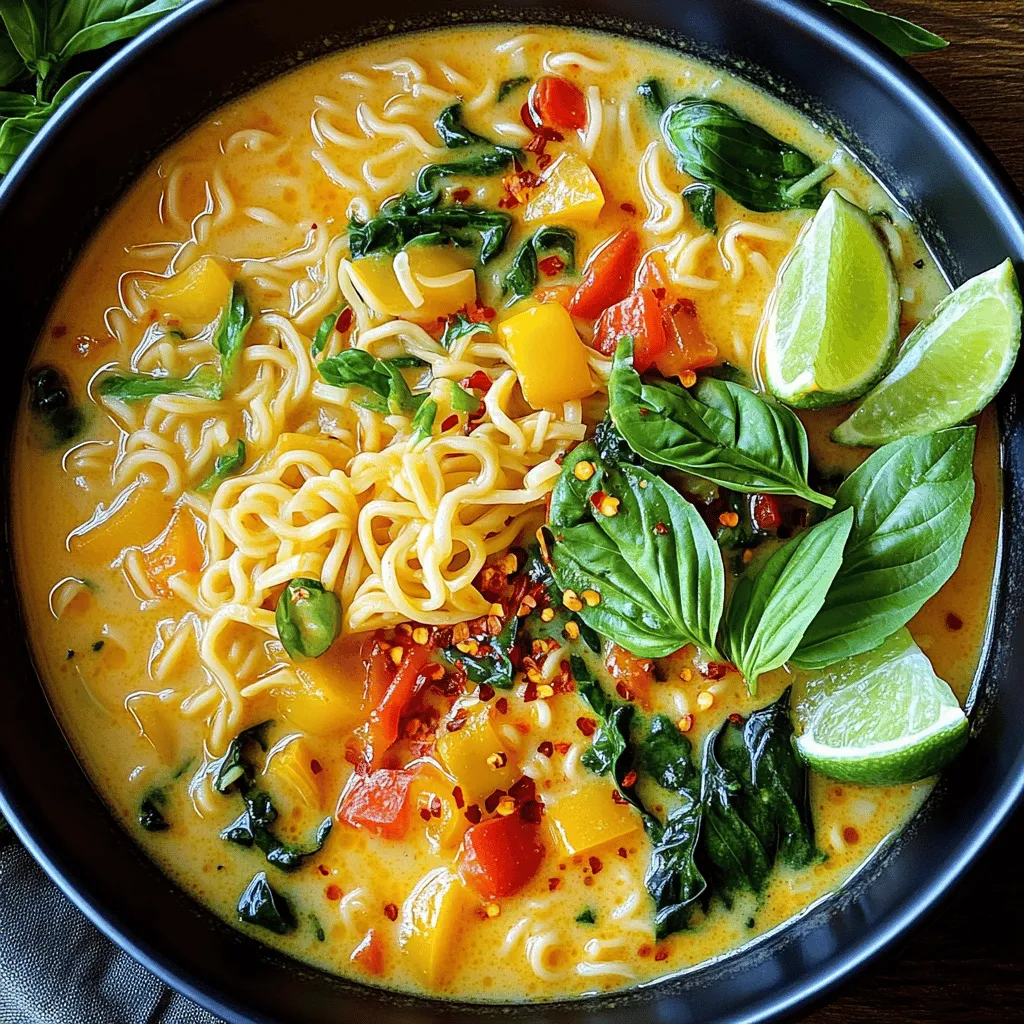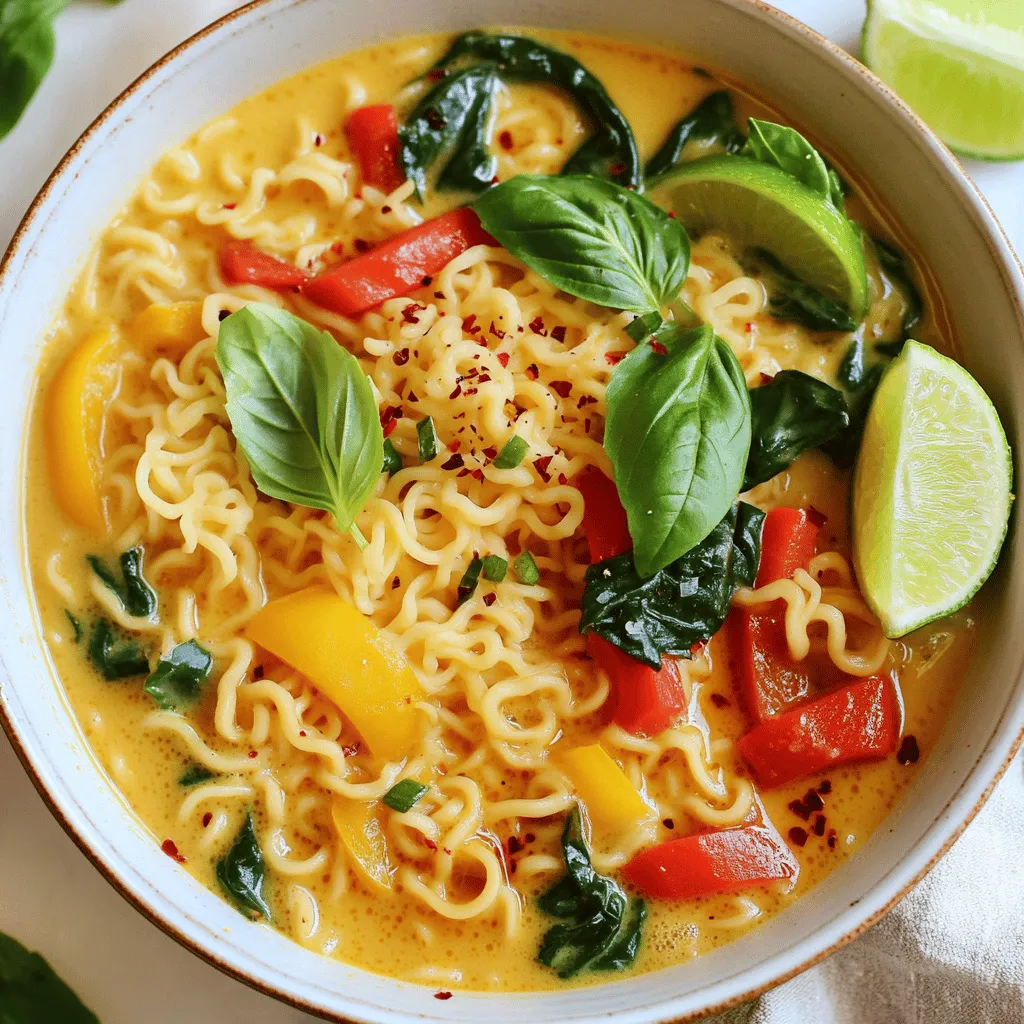Get ready to dive into a bowl of Thai Coconut Curry Ramen that bursts with flavor! This rich and warming dish combines the best of Thai cuisine with the comfort of ramen. In this recipe, I’ll guide you through easy steps, ingredient swaps, and tips to make it perfect. Whether you’re a novice cook or a seasoned pro, this delectable ramen is sure to impress. Let’s whip up some deliciousness together!
Ingredients
List of Ingredients
– 2 packs of fresh ramen noodles
– 1 can (400ml) coconut milk
– 2 cups vegetable broth
– 2 tablespoons red curry paste
– 1 tablespoon soy sauce
– 1 tablespoon lime juice
– 1 teaspoon brown sugar
– 1 cup bell peppers, sliced (red and yellow)
– 1 cup baby spinach leaves
– 1 cup sliced mushrooms (shiitake or button)
– 1 can (15 oz) chickpeas, drained and rinsed
– Fresh basil leaves for garnish
– Lime wedges for serving
– Chili flakes or sliced fresh chili for heat (optional)
Ingredient Substitutions
You can swap fresh ramen noodles for dried ones if you can’t find them. Just adjust the cooking time. If you don’t have coconut milk, use almond or soy milk for a lighter taste. Vegetable broth can be replaced with chicken broth for added flavor. For a spicy kick, you might try adding curry powder instead of red curry paste. If bell peppers aren’t available, zucchini or carrots work well too.
Health Benefits of Key Ingredients
– Coconut milk: This rich milk provides healthy fats and keeps you full.
– Chickpeas: They are high in protein and fiber, aiding digestion.
– Spinach: Packed with iron and vitamins, spinach boosts your health.
– Bell peppers: These colorful veggies are rich in vitamins A and C.
– Mushrooms: They contain antioxidants and can help your immune system.
Using these ingredients not only makes your dish tasty but also nutritious. Enjoy creating a meal that is both rich in flavor and good for you!
Step-by-Step Instructions
Detailed Cooking Instructions
1. First, grab a large saucepan and place it on medium heat.
2. Pour in the can of coconut milk and the vegetable broth. Stir them together until they mix well.
3. Next, add the red curry paste, soy sauce, lime juice, and brown sugar. Whisk until the curry paste fully dissolves.
4. Now, toss in the sliced bell peppers and mushrooms. Let them simmer for about 5 minutes. This helps them soften.
5. Stir in the chickpeas and let them cook for another 3 minutes. This allows the flavors to mix well.
6. In a separate pot, cook the ramen noodles per the package instructions. Once done, drain and set them aside.
7. Add the baby spinach to your curry broth. Cook for 1-2 minutes until the spinach wilts.
8. To serve, place cooked ramen in a bowl. Ladle the coconut curry broth and veggies over the top.
9. Finish by garnishing with fresh basil leaves. Serve with lime wedges and optional chili flakes for heat.
Timing for Each Step
– Mixing coconut milk and broth: 2 minutes
– Combining curry paste and other ingredients: 3 minutes
– Simmering bell peppers and mushrooms: 5 minutes
– Cooking chickpeas: 3 minutes
– Cooking ramen noodles: 5-7 minutes
– Wilting spinach: 1-2 minutes
– Total cooking time: About 30 minutes
Tips for Achieving the Best Texture
– Simmer the broth gently; avoid boiling to keep it creamy.
– Stir the broth often while adding ingredients to prevent sticking.
– Don’t overcook the spinach; it should be bright green and tender.
– Use fresh noodles for a chewier texture, but dried works too.
– Adjust the simmering time for veggies to your liking; you can keep them crisp!
Tips & Tricks
Flavor Enhancements
To boost the flavor of your Thai coconut curry ramen, try these tips:
– Use fresh herbs like cilantro for a bright taste.
– Add a splash of fish sauce for umami depth.
– Squeeze extra lime juice before serving for freshness.
– Consider adding a touch of peanut butter for richness.
These small changes can lift your dish from good to great. Explore different toppings too!
Common Mistakes to Avoid
Here are some common mistakes to watch out for:
– Don’t overcook the vegetables; keep them crisp.
– Avoid using too much curry paste; start small and add more if needed.
– Make sure to rinse the chickpeas to reduce saltiness.
– Cook the ramen noodles separately to keep them firm.
Being mindful of these points will lead to a better meal.
Serving Suggestions
Serve your ramen in a deep bowl for a great look. Here are some ideas:
– Top with fresh basil leaves for color and taste.
– Include lime wedges on the side for a zesty kick.
– For heat, add chili flakes or sliced fresh chili.
– Pair with a light salad for a complete meal.
These suggestions can make your dining experience more enjoyable.

Variations
Vegan or Vegetarian Modifications
You can easily make this dish vegan. Use vegetable broth and coconut milk, as listed. Instead of chickpeas, try using lentils or any preferred bean. You can also add more veggies like carrots or zucchini for extra nutrients. This keeps the meal tasty and filling without any meat.
Adding Proteins (Chicken, Tofu, etc.)
If you want to add protein, chicken works great. Use boneless, skinless chicken thighs or breasts. Cut the chicken into small pieces and cook them in the broth before adding other veggies. For a plant-based option, try tofu. Press and cube the tofu, then pan-fry it until golden. Add the tofu to the curry at the end for a lovely texture.
Spicy Variations
If you enjoy heat, add chili flakes or fresh sliced chili. You can mix these into the broth while it simmers. If you like it extra spicy, use a spicier red curry paste. Taste as you go, so you find the right balance for your palate. Enjoy the heat and flavor!
Storage Info
How to Store Leftovers
To store leftover Thai Coconut Curry Ramen, let it cool first. Transfer it to an airtight container. Make sure you separate the noodles from the broth. This helps keep the noodles from getting too soggy. You can store the curry broth and veggies together. Keep the container in the fridge for up to three days.
Reheating Tips
When you’re ready to eat, reheat the broth on the stove or in the microwave. If using a pot, warm it on low heat. This prevents burning. Add a splash of broth or water if it thickens too much. Heat the noodles separately, then combine them with the broth. This keeps the texture nice.
Shelf Life of Ingredients
– Coconut milk: Unopened cans last for months in the pantry. After opening, store it in the fridge for 4-5 days.
– Vegetable broth: Unopened, it can last for a year. Once opened, use it within 3-5 days.
– Fresh ramen noodles: These last about a week in the fridge. Check the package for exact dates.
– Chickpeas: Canned chickpeas can stay good for years. After opening, use them in 3-4 days.
Storing your ingredients properly helps maintain their quality and taste.
FAQs
Can I make this dish gluten-free?
Yes, you can make this dish gluten-free. Use gluten-free ramen noodles instead of regular ones. Check that your soy sauce is gluten-free as well. Many brands offer tamari sauce, which is a great alternative. This way, you can enjoy the same rich flavors without the gluten.
What can I use instead of coconut milk?
If you cannot use coconut milk, try almond milk or cashew cream. Both options add a nice creaminess. You can also use soy milk, but it will change the flavor a bit. Just remember to add some extra seasoning to keep it tasty.
How do I adjust the spiciness level?
To change the spice level, add or reduce the red curry paste. Start with less if you prefer a milder flavor. You can also add fresh chili slices or chili flakes for more heat. Just taste as you go so you find the right balance for you.
This blog post covered key ingredients, step-by-step cooking, and handy tips. You learned about ingredient swaps and health perks. I shared ways to tweak flavors and avoid common mistakes. Storage tips and variations help you make this dish your own.
In the end, cooking should be fun and easy. Use these insights to create a tasty meal you love. Enjoy experimenting and sharing with others!

